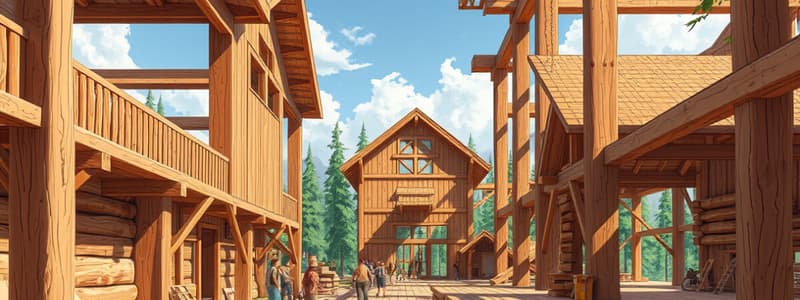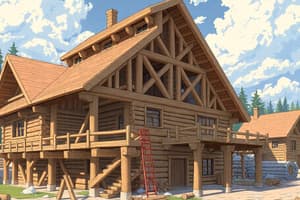Podcast
Questions and Answers
What is the primary characteristic of Heavy Timber Construction?
What is the primary characteristic of Heavy Timber Construction?
- Use of thin wooden panels for aesthetic purposes
- Use of lightweight steel framing
- Use of large, solid wood beams and columns for structural support (correct)
- Use of concrete blocks for foundation work
What distinguishes Mill Construction from other forms of Heavy Timber Construction?
What distinguishes Mill Construction from other forms of Heavy Timber Construction?
- It uses plastic beams
- It features hollow columns
- It is primarily used for residential buildings
- It uses non-combustible exterior walls (correct)
What is the natural fire resistance feature of Heavy Timber Construction?
What is the natural fire resistance feature of Heavy Timber Construction?
- The wood is treated with fireproof chemicals
- The beams are coated with a metal layer
- The thick wood members char on the outside, insulating the interior (correct)
- The wood is soaked in water before installation
During what period did Heavy Timber Construction see a significant increase due to industrial needs?
During what period did Heavy Timber Construction see a significant increase due to industrial needs?
Why is Heavy Timber Construction considered environmentally beneficial?
Why is Heavy Timber Construction considered environmentally beneficial?
Which of the following is a challenge associated with Heavy Timber Construction?
Which of the following is a challenge associated with Heavy Timber Construction?
What is the primary structural function of a beam in Heavy Timber Construction?
What is the primary structural function of a beam in Heavy Timber Construction?
What material is primarily used in Heavy Timber Construction?
What material is primarily used in Heavy Timber Construction?
What is a consequence of moisture exposure in Heavy Timber structures?
What is a consequence of moisture exposure in Heavy Timber structures?
What purpose do Mass Plywood Panels (MPP) serve in modern construction?
What purpose do Mass Plywood Panels (MPP) serve in modern construction?
What does the fire resistance of Heavy Timber structures primarily rely upon?
What does the fire resistance of Heavy Timber structures primarily rely upon?
In the context of building codes for Type IV-A construction, what are the new height limits?
In the context of building codes for Type IV-A construction, what are the new height limits?
What critical factor affects the fire safety strategy in Heavy Timber buildings?
What critical factor affects the fire safety strategy in Heavy Timber buildings?
Why might abandoned Heavy Timber Buildings pose a significant risk?
Why might abandoned Heavy Timber Buildings pose a significant risk?
Which firefighting recommendation is advised for vacant Heavy Timber Buildings?
Which firefighting recommendation is advised for vacant Heavy Timber Buildings?
What can happen if fire barriers are removed from Vacant Heavy Timber Buildings?
What can happen if fire barriers are removed from Vacant Heavy Timber Buildings?
What role does 'Prefire Planning' play in managing Heavy Timber structures?
What role does 'Prefire Planning' play in managing Heavy Timber structures?
What is a common attribute of modern Heavy Timber Construction like CLT?
What is a common attribute of modern Heavy Timber Construction like CLT?
What is a 'beam' in construction?
What is a 'beam' in construction?
What defines a 'column' in the context of construction?
What defines a 'column' in the context of construction?
How does 'char' contribute to fire resistance in heavy timber?
How does 'char' contribute to fire resistance in heavy timber?
What is the primary function of 'non-combustible materials' in mill construction?
What is the primary function of 'non-combustible materials' in mill construction?
What denotes the importance of 'engineered wood products' in modern construction?
What denotes the importance of 'engineered wood products' in modern construction?
Which description accurately represents 'Mill Construction'?
Which description accurately represents 'Mill Construction'?
What function do 'Fire Cut Girders' serve in Mill Construction?
What function do 'Fire Cut Girders' serve in Mill Construction?
What is the purpose of a 'scupper' in Mill Construction?
What is the purpose of a 'scupper' in Mill Construction?
Why are concealed spaces avoided in Mill Construction?
Why are concealed spaces avoided in Mill Construction?
What is a misconception about 'Slow Burning' in Heavy Timber Construction?
What is a misconception about 'Slow Burning' in Heavy Timber Construction?
In Heavy Timber Buildings, what is the danger of 'Conflagration Breeders'?
In Heavy Timber Buildings, what is the danger of 'Conflagration Breeders'?
What fire hazard is linked to the use of unprotected steel in Heavy Timber Buildings?
What fire hazard is linked to the use of unprotected steel in Heavy Timber Buildings?
Why are sprinkler systems vital in Heavy Timber Buildings?
Why are sprinkler systems vital in Heavy Timber Buildings?
What characterizes 'Cross-Laminated Timber (CLT)'?
What characterizes 'Cross-Laminated Timber (CLT)'?
What issue does 'delamination' present in CLT during a fire?
What issue does 'delamination' present in CLT during a fire?
Flashcards are hidden until you start studying
Study Notes
Heavy Timber Construction Characteristics
- Heavy Timber Construction utilizes large, solid wood beams and columns for structural integrity.
- Fire resistance is achieved as thick wood members char on the outside, creating an insulating barrier for the interior.
Mill Construction Specifics
- Distinguished from Heavy Timber Construction by the use of non-combustible exterior walls.
- Incorporates thick, solid wood floors and large timber beams alongside non-combustible materials.
Environmental Benefits
- Heavy Timber is considered environmentally friendly due to wood being a renewable resource.
Challenges
- Requires regular maintenance to prevent moisture intrusion and potential fire hazards.
- Modifications to old Heavy Timber buildings can compromise fire resistance, especially when unprotected steel is involved.
Structural Components
- Beams serve as horizontal structural members supporting roofs and floors.
- Columns are vertical members carrying load from beams to the foundation.
Fire Resistance
- Non-combustible materials in Mill Construction prevent ignition during fire exposure.
- "Char" formation on large timbers acts as a protective layer, preserving the core from combustion.
Significant Terminology
- "Conflagration Breeders" refer to structures that may initiate large, uncontrollable fires.
- "Delamination" in Cross-Laminated Timber (CLT) can weaken the structure during a fire.
Modern Engineering
- Engineered wood products have enhanced strength and stability compared to solid wood.
- Mass Plywood Panels (MPP) consist of layers of wood veneers bonded together, used in taller structures.
Safety Measures
- Functional sprinkler systems are critical for quick fire control and preventing large-scale fires.
- Fire Cut Girders in Mill Construction prevent walls from collapsing if girders fail.
Code and Regulation
- New Type IV-A construction codes permit up to 18 stories with mass timber covered in gypsum board for enhanced fire safety.
- Minimum wood column dimensions in Heavy Timber buildings are 8 inches in any dimension, with specific sizes for supporting loads.
Emergency Preparedness
- Prefire planning is essential for determining effective firefighting strategies and resource allocation.
- Caution is necessary during firefighting in modified Heavy Timber buildings due to the risk of unprotected steel elements.
Case Studies
- The Worcester Cold Storage Fire highlighted the need for effective fire prevention measures in vacant heavy timber buildings.
Key Points on Fire Hazards
- Concealed spaces in modern renovations can allow undetected fire spread, raising safety concerns.
- Vacant Heavy Timber buildings without proper fire barriers can experience rapid fire propagation.
Studying That Suits You
Use AI to generate personalized quizzes and flashcards to suit your learning preferences.




